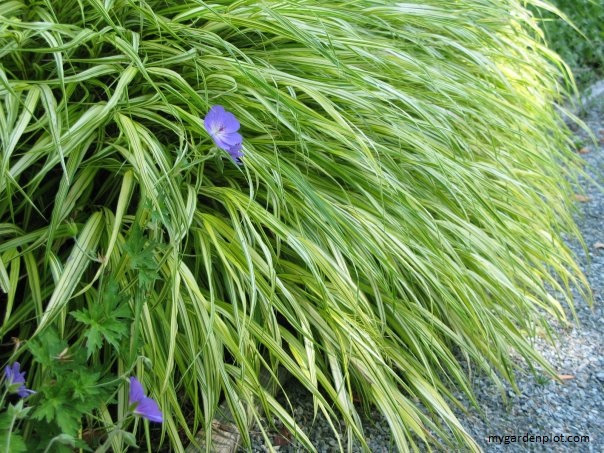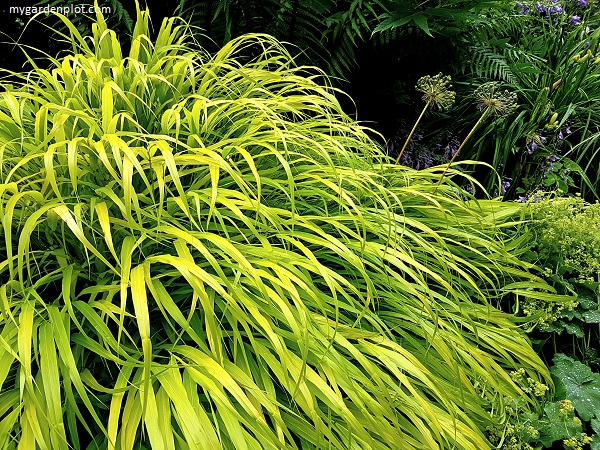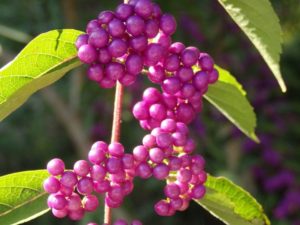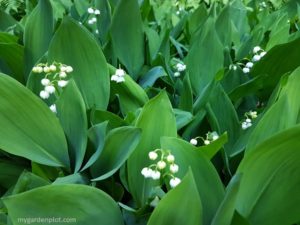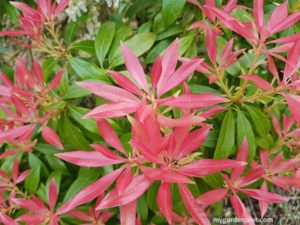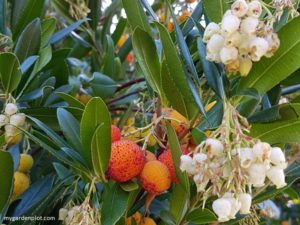Growing Ornamental Grass Hakonechloa macra (Hakone Grass, Japanese Forest Grass): A Comprehensive Guide
The Hakonechloa macra, more commonly known as Hakone grass, is a beautiful ornamental grass with smooth arching leaves forming attractive, dense mounds. The stunning foliage resembles bamboo but forms a graceful low mound that is easy to maintain. The Hakone grass is ideal for woodland gardens, borders or containers adding texture and movement to your garden. It is also known as Japanese forest grass, and as the name implies, it is native to Japan.
While it is valued in shade gardens and thrives under a forest canopy’s coolness, the Hakone grass is spectacular as a potted plant. It is slow-growing, cold-hardy and low-maintenance, making it ideal for container gardening, especially if you don’t have time, or the inclination, to repotting every year. Below are tips for growing your Hakone grass and when to cut back at the end of the season.
In the garden, the Hakone grass pairs beautifully with contrasting hostas, and softening the border edging along with lily of the valley ground cover or ferns. It is ideal for slopes, edges and is beautiful as ground cover, thriving with minimal care once established. The Hakone grass does have a flower but is rather insignificant. Knowing where best to plant this moist-loving grass will ensure you have years of enjoyment.
The leading H. macra (Hakone grass), with its deep green narrow leaves impart a richness of uniformed colour that offers a gentle texture in any garden. It is the most adaptable and hardy of Hakone grasses and is eye-catching planted next to broad-leaf plants or with flashes of colour from fuchsias or bellflower.
Gaining in popularity are the variegated Hakone grasses with gold and yellow that add a spark of brightness and contrast in a shade garden. Planted along with contrasting blue or purple, whether, with a pot or companion plant, it is truly one of the most elegant ornamental grasses to have in the garden. See the list below of recommended Hakone grass cultivars.
The Hakone grass, or Japanese forest grass, is non-toxic to pets and humans.
Hakone Grass At A Glance
Type: Herbaceous perennial (ornamental grass)
Location: Partial sun to full shade
Season of Interest: Spring to Autumn
Height and spread: Up to 60 cm (2 feet) with a broader spread at maturity
When To Prune: Early Spring (see maintenance information below)
Cold Hardiness Zones: 5, 6, 7, 8, 9 (some protection recommended in colder zones)
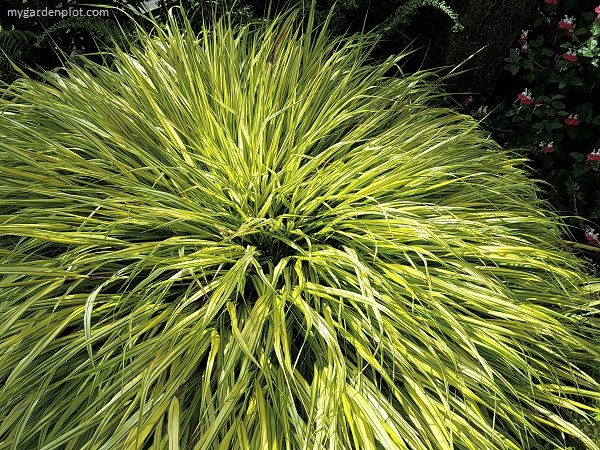
Where To Plant And How To Care For Your Hakone Grass
While most ornamental grasses prefer sunny locations, the Hakone grass thrives in part shady to cool filtered part sunny site. Avoid full sunny areas. Selecting a shade spot under trees or a north-facing area in your garden is preferable. A sunny morning location is suitable for a mature plants, but avoid harsh afternoon sun that can scorch leaves. Space about 18-24 inches apart.
It grows best in moist, well-drained, organic soil. It is adaptable with soil pH and grows well in either acid, alkaline or neutral soil. For best results amend soil with compost for fertility and drainage. Water regularly until it is established, and especially during the hot summer months, water deeply weekly and increase frequency in heat or drought. Consistent moisture is needed but avoid waterlogging with good drainage to prevent root rot.
In spring apply a light application of balanced fertilizer or compost. Avoid excess nitrogen.
It is generally slow to establish, but it can tolerate more heat and morning sun once it does. It is hardy and is long-lived in the right conditions.
The Hakone grass spreads by rhizomes but keeps a more compact form and is considered non-invasive. No pruning or staking is needed. It is slow-growing and requires minimum to no dividing for several years. Every three to four years, divide clumps in spring ensuring roots on each section and replant. This improves airflow.
The Hakone grass is generally disease and pest-free, and deer resistant. It can occasionally be nibbled by slugs or snails, but using a little diatomaceous earth or slug bait can solve this issue easily. As noted above improved drainage will remove the possibility of root or crown rot usually associated with soggy soil.
Can You Grow Japanese Forest Grass In Pots?
Yes you can! Outdoor potted plants are more susceptible to the elements than those growing in the ground, and will need more frequent watering and fertilizing. During summer avoid the scorching sun and water your Japanese forest grass at least two to three times a week. In colder regions, shelter in winter and protect container plants from prolonged freezing.
How it started…
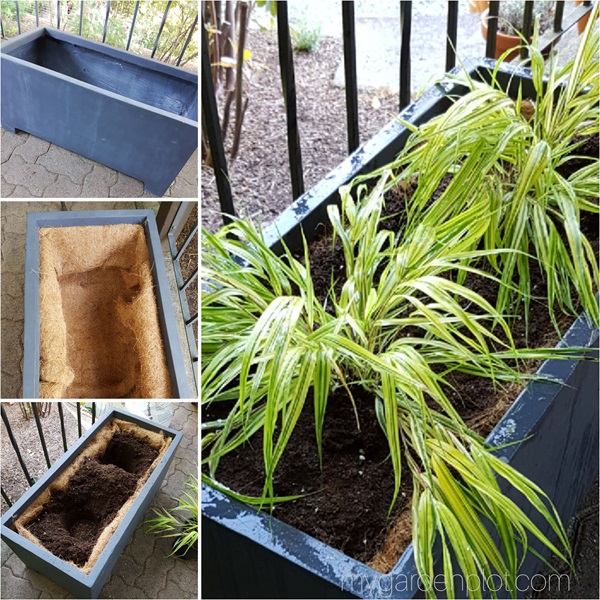
…and a couple of years later, the arching leaves of our Japanese forest grass is a graceful winner on our patio.
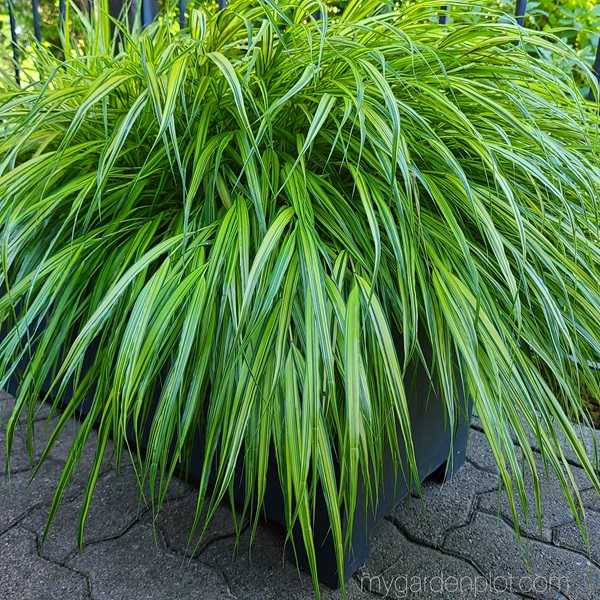
Hakone Grass Winter Care and Spring Maintenance
At the end of the season, the leaves will die back, and the plant will go dormant over the winter. There is really nothing to do to it over the winter. Mulch is recommended in colder zones 5 through to 7. Leave foliage for winter interest. In colder regions also protect container plants from prolonged freezing.
In early spring, remove the leaves and cut back the dead stems to ground level. This will provide a tidy area as your Hakone grass emerges again in the spring.
Add a light mix of compost and mulch before new growth starts will set it well for the year. It is a welcome sight in a shady spring garden.
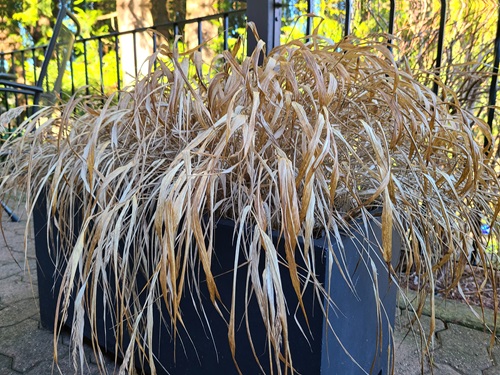
Recommended Hakone Grass Varieties
Known for its cascading foliage and seasonal color changes, here are some of the recommended varieties ideal for woodland gardens, borders, or containers:
H. macra (Hakone grass) ‘Aureola’ – The Aureloa is the most popular of Hakone grasses and favoured for its new growth and fall colours. It is undoubtedly my favourite. The leaves are striped yellow and green, which turns intense copper red in the autumn. Golden cultivars, like the Aureloa, tolerate morning sun but placement to avoid harsh afternoon sun is required.
H. macra (Hakone grass) ‘All Gold’ – This golden beauty is rightly named All Gold. It lighten any shade garden and is particularly beautiful next to board-leaf blue hostas. In autumn the foliage fades pinkish. Needs light shade.
H. macra (Hakone grass) ‘Alboaurea’ – the dense variegated leaves of the Alboaurea is a mix of creamy-white, yellow and green, which turns reddish in autumn.
H. macra (Hakone grass) ‘Sunflare’ – The Sunflare is a version of the All Gold that is a genuinely enchanting mass of golden-yellow foliage. The difference is that the leaves’ tips occasionally turn burgundy during the summer giving it a festive look. In autumn, the foliage turns to burnt orange.
